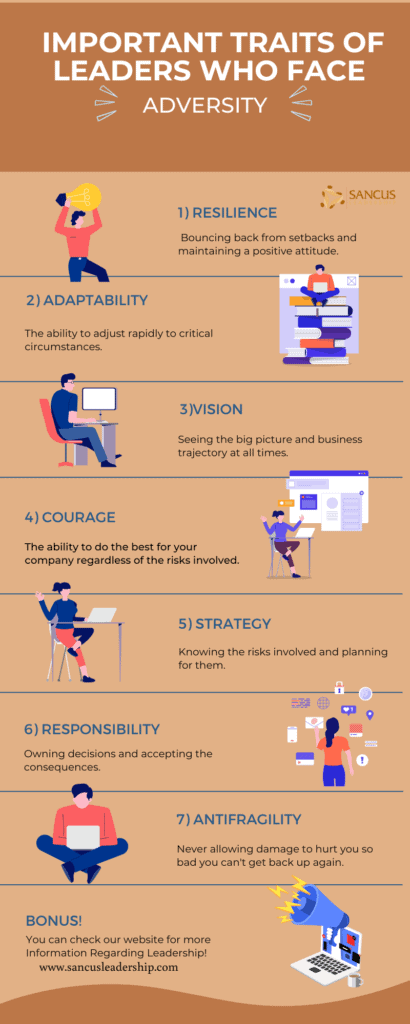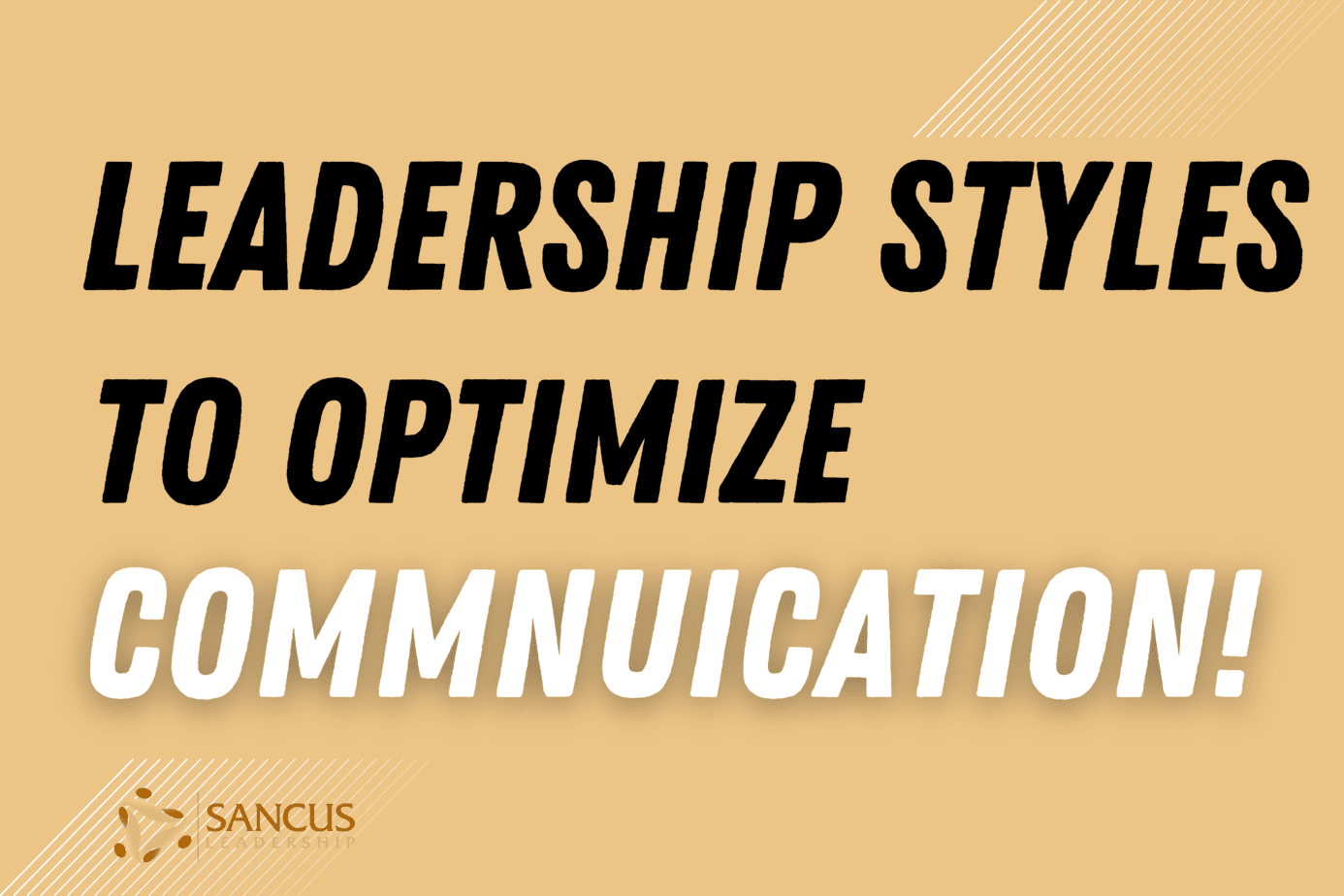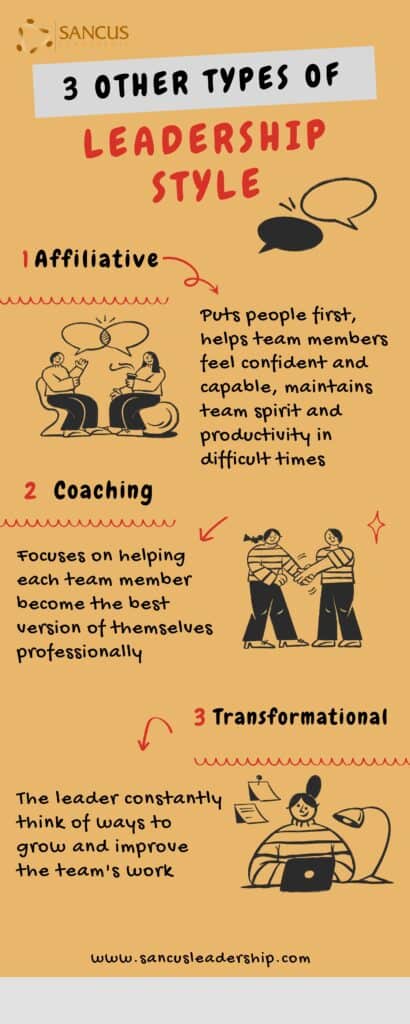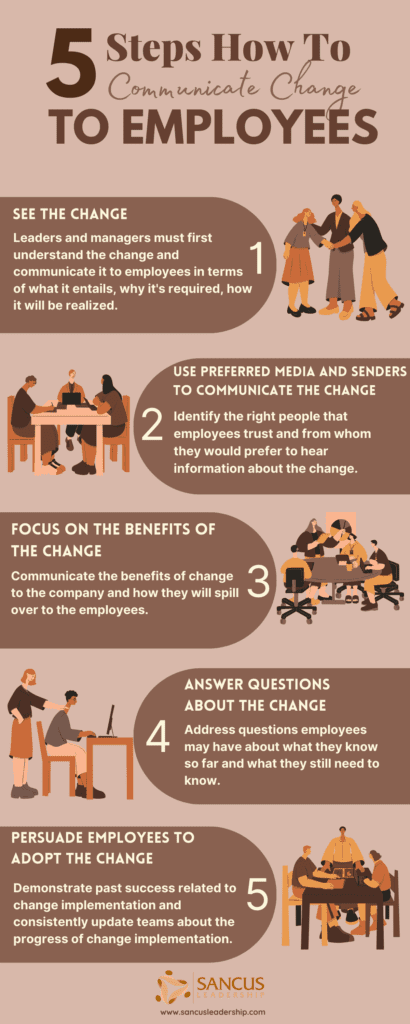My most recent small team was a high-performing unit of six; this was the most exhaustive and intense time as a leader I had experienced. Previously, I led teams of 100+, but my time as a manager and commander for this team was by far the most challenging.
I learned a lot from my mistakes training other leaders and watching their results.
First, let’s look at what small-team leadership is:
Small team leadership (STL) is “the art of leading small teams.” Small teams are groups of two to ten people working together towards a common goal. The best small team leaders focus on understanding team members’ strengths and weaknesses and understanding employees’ “why.”
Small team leaders know exactly how to communicate with each individual so that the organization’s goals can be met while maintaining high morale and employee engagement.
Small team leadership is unique, and in this post, I want to make sure you stay clear of the biggest mistakes and execute flawlessly on the mission critical:
What Is Unique With Being The Leader of a Small Team?

As the leader of a small team, you will have more one-on-one time with the individuals of your team, or at least you should have; this means they will be able to see all aspects of you, as a leader, as a friend, and as a human being.
This forges trust fast, If, and this is a big one, If you are an authentic and proficient leader.
Since all your moves will be visible to your team, you can not hide behind the masses of a large group. Your team will watch your every move, and they will compare your talk with your walk. And if these align and are also accepted by the crew, then you my friend, are driving a Ferrari on the highway of organizational goals.
The power of this intimate connection is many times overlooked. I have seen many team leader colleagues assume that whoever is on their team is there because they want to. This a big mistake because assuming such a vital component could set you up for some severe employee retainment issues.
One of the best ways to become a prominent small team leader is to avoid the great mistakes made by others, and by others, I mean myself…
How to Kill Performance On a Small Team!

Small teams are better at innovation and creativity, but this is not a given! If you do not avoid the following mistakes, you will be creating a very tough situation to lead from.
These are lessons from 14 years of leading but also from being led and developing new leaders.
Here are four things you must avoid if you want to be an effective small-team leader!
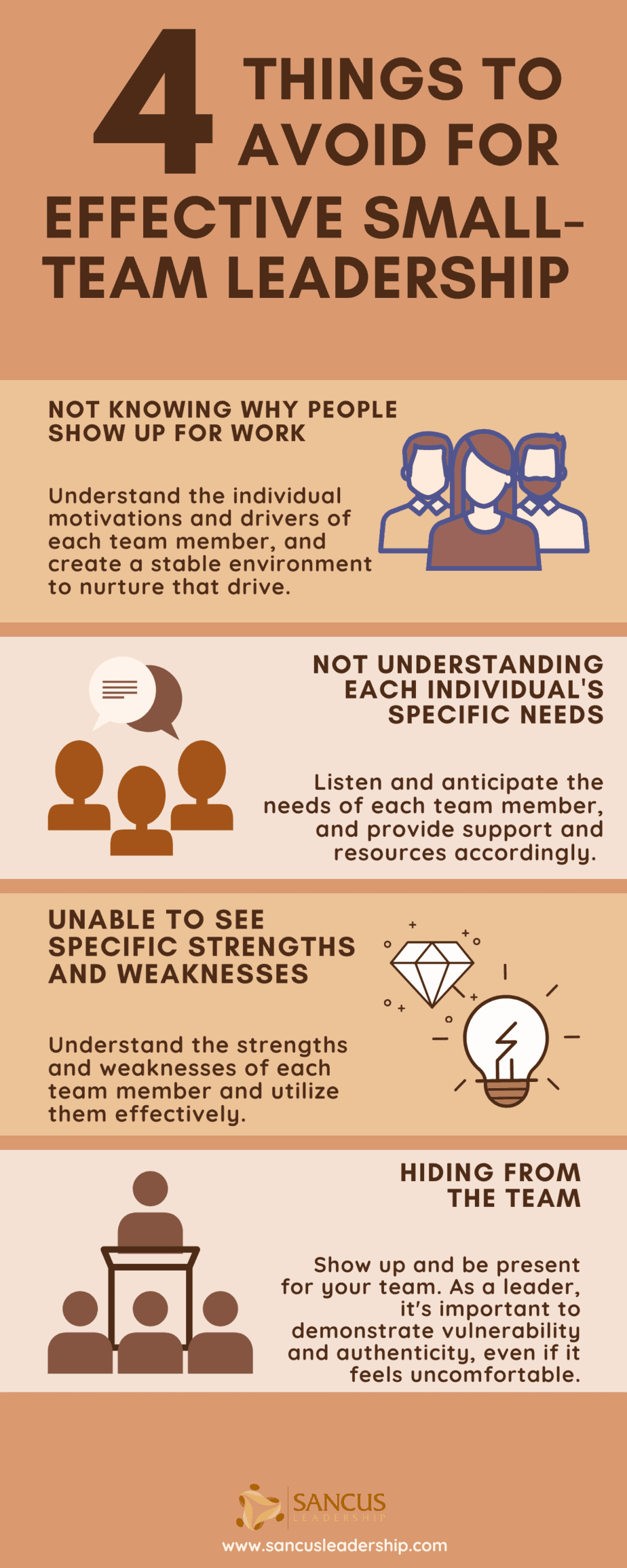
1. Not Knowing EXACTLY WHY People Show Up for Work
During my time as a Bomb Disposal operator, the norm was that teams did one deployment together and then split up, either leaving the army or doing something else within the arms.
My team stayed together for five years and four deployments, longer than any other team in the history of my company, and the secret?
Understand WHY your people ACTUALLY show up for work and find ways that you can nurture that drive.
Here’s an example: I had a team member whose greatest drive was to have a feeling of belonging, not to feel like he was dispensable. Knowing this, I did my best to create a stable environment (by army measure) so that we all could feel at home within the team.
Building a team is like building a very strong ship, no matter the storms surrounding you, on your ship, you will all be safe.
In combination with a few other factors (that you can read about here), this is the absolute most powerful way to keep people on your team forever!
2. Not Understanding Each Individual’s Specific Needs
I learned this the hard way. I pushed a team member too hard, and he mentally crashed, bursting into tears in front of the whole team. I felt ashamed and had failed as a leader; if I had talked less and listened more, it would have become evident to me that he needed recovery and a helping hand.
Not a pushing hand…
If we crash, it takes 10x more time to repair than if we slow down, do the necessary maintenance and avoid the crash entirely.
We, as leaders, must listen and anticipate what our people need; this is different from giving them whatever they ask for. Now, as the leader, it is your duty to look beyond what they say they want and give them what they really need.
It’s a fine line between overparenting and not taking responsibility.
3. Unable To See Specific Strengths and Weaknesses
Your understanding of your teammates can be compared to the individual materials of a machine. If we make the cogs out of plastic and the steering wheel from metal, we will have a pretty useless car.
But when we understand the characteristics of the plastic and metal that make up our “leadership car,” we can utilize it more effectively. Not knowing your team’s strengths and weaknesses is like building a car with unknown materials.
You MUST Exploit your team’s strength, and leverage it to the moon! Your weaknesses, on the other hand only need to be “good enough”!
4. Hiding From The Team
I remember the first encounter with my new team, they were out practicing skills, and I was to lead them through a task for the first time. I was nervous, and I had volunteered for it. I knew they would watch my every move and that this situation had the potential to really screw up my start with them.
I wanted to say, “I don’t have time right now,” and hide in my office, but I knew “showing up” was important, so I went out and gave it my best. A few years later, I got this comment from a former teammate of that team:
“You were the ONLY one who came out and revealed yourself, we [the teams] respected that!”
My takeaway? It’s scary to be a leader, especially an authentic small team leader, where the boundaries between family and colleagues can be very blurry. But if you nail it, your team becomes something to be proud of and valuable for the rest of your life.
Now that we have explored the big pitfalls of small team leadership, it is time to look at better options to lead.
Real-World Tips on How to Effectively Lead a Small Team

Build REAL Trust
You have probably heard that trust is the glue that keeps the team together. While this makes partial sense, trust is way more than just keeping people together.
Trust is a shortcut to productivity, trust removes stress and anxiety, trust enables creativity, and trust IS the team.
“If there is no SOLID trust on the team, I would say you don’t have a team; what you have is a gathering of people.”
Solid trust, forged through healthy conflict and continuous feedback, will make your team ask fewer questions because they know that if they get it wrong, the team will have their back; this means a higher-paced work environment and greater output.
And if you build your team with genuine care in mind, long-term and authentic care, that is, then there will be no more Sunday anxiety before work, or the meetings will feel much more honest and productive.
Trust is setting your team up for “useable failure.” Let me explain. In some aspects, your team will fail. That’s just how the world works. Now either you can have a culture that makes people hide the small mistakes, so you can’t learn from them, leading to big mistakes and significant failures.
Or, every time someone makes, what you think is a mistake, you assume that it was incompetence rather than malevolence. The fix for incompetence is training, and the fix for malevolence is something totally different.
“Never assume malevolence if incompetence is enough to explain the problem.”
Communicate Goals Clearly and Precisely
If you think defining goals isn’t a big deal and that there are more important skills that you need to work on as a leader, then I ask you this:
In one sentence: tell me your top target, purpose, and requirements.
If you can’t quickly and clearly state EXACTLY what it is you are supposed to achieve, how can you expect others to work in your “spirit” and direction? After 12+ years as an Army officer, guiding all types of units, this is one of the key components to getting the right things done on time.
If your team understands What is important (Top target), they understand Why it is important (purpose), and they know what SPECIFIC actions lead to success (requirements). As a leader, you can start clearing obstacles (contingency planning) for your team to do their thing, and you can now plan for the future, so when the task is complete or the situation changes, you already have a direction for where to go.
That’s great leadership!
Strengthen ALL That is Good and Hinder What is Bad
Maybe you have heard, “You need to work on your weaknesses.” or “Make your faults your strengths.” I say, screw that. Why would you put your energy where you are having the least success?
Let’s say you are the commander of an attacking unit trying to break through enemy lines. Suddenly you get two reports; one states, “We are struggling with logistics and aren’t achieving our objectives,” and the other states, “We are pushing forward, and the enemy seems to be on its back foot.”
What would you do? Hopefully, you said, “Let’s go strengthen the offense and achieve a decisive victory on the battlefield!” But from experience, I know that many leaders out there choose to be the eternal repairman, continuously trying to fix what is broken, putting energy into fixing those logistics, and making sure everything is equal.
This is the wrong way of doing it. If we understand the overarching goals, winning the fight (or selling products, for that matter), then we must do the things that get us closer to the win, not something that just keeps us in the fight.
So exploit your strengths and accept your weaknesses if you want success with your top goals. Select your priorities and honor them.
“If everything is important, nothing is important.”
Understand Accumulative Stress
I once made the mistake of thinking, “How can he be so tired and stressed when we’ve had such a slow week?” Maybe you have done something similar? This is a very common mistake that I see. Our team must be seen in relation to everything else that is going on in their lives.
There are obvious stressful things, such as the death of a close one, and usually, we as leaders are pretty good at understanding that. But there are way more subtle and hard-to-see stressors; maybe they don’t even see it themselves yet.
A few years back, I had a close friend and a team leader performing differently than usual. For months, this low performance would continue. When we sat down to talk, he would mention being tired, which is very normal considering the high-paced environment we were in, and we couldn’t find anything unusual.
This could have resulted in treating him as an underperformer and taking him off the team leader position. But instead, we chose to start diving deeper and broader into understanding where this originated from. After many hours of talking and a few trips to the medical facility, it turned out he had a very rare, nonsymptomatic disease probably caused by being bitten by a tic.
He quickly got back into shape, and his performance was through the roof.
We got many things out of this situation. We forged trust by not giving up on each other. We didn’t have to find someone else to train and replace him, and we built a culture in the organization that we ACTUALLY value our people!
Create a Culture of True Openness
Ever had one of those after-meeting discussions? One where the real issues pop up, one where people say, “This is crazy,” or “I can’t believe how stupid this is.” Why do you think people suddenly open up? Why didn’t they say anything during the meeting?
I mean, that’s what the meeting was for, and the manager has often said that we have an open climate where we can talk about anything…
Of course, there are some logistical matters, such as there wasn’t enough time.
But the real issue is usually a combination of two things: first, you have probably heard or felt, “My opinion doesn’t matter, so why should I say anything anyways,” the second, “If I say something, I’m afraid how people will think.”
Here’s food for thought; the latter isn’t about “What people will think about me.” It’s about “How will people treat me.” That’s a big difference and a topic for another day.
Self-censured team culture is a BIG deal. It will screw your entire team or organization’s narrative, and it will generate a straight path to group thinking and basically kill creativity and innovation.
“It will screw your entire team or organization narrative and it is a striaght path to group think and basically kills all creativity and innovation.”
Many times this comes sneaking from the dark. The manager often has the best intentions and truly wants an open climate and a marketplace of ideas. But what most managers need to see is if you only reinforce useful ideas and always XXXX on non-useful ones.
Then slowly but surely, you are molding the narrative and the discussions to only encourage ideas that people think that you or the group will immediately approve of.
The key here is to not explicitly judge the ideas that are coming in. You don’t have to encourage the idea, but you must encourage the process of generating the idea!
“You dont have to encourage the idea, but you must encourage the process of generating the idea!”
You will get more of whatever you encourage, and the opposite is also true. So if you genuinely want an open climate, you must encourage the individual who generated the idea, even if you think the idea is stupid and not worthwhile.
And this is true. Most ideas, maybe even 99%, are useless, but that isn’t the point. The 1% idea, the Google or the Tesla of ideas, is worth all the stupid ideas. If you want to access the 1% of great ideas, you must be prepared to face “the 99%” as well. You do this by removing obstacles (self-censorship), allowing the free marketplace of ideas to grow.
Use Facetime Wisely
A lot of us are working remotely, at least in part. This is very comfortable for the individual, but it makes forging your team much harder for you as a leader.
It’s like chatting with your Tinder date for two weeks, and when the date finally happens, you realize in two seconds that there is zero chemistry, you don’t like the same jokes, and your communication tempo is way off.
In the case of the date, you’ll probably just say thank you and never see each other again, but on a team, it’s different, right?
In-person time is unbeatable when it comes to getting to know someone. Slack, zoom, or whatever you use is, at best, a 1% solution when building rapport and understanding with the people you serve.
It should be a priority of you, as a leader, to meet each and every one of your team regularly!
The hierarchy of communications is something like this;
- In-person 1on1
- In-person group
- Videocall 1on1
- Audio call 1on1
- Videocall Group
- Audio call Group
- Text (email, or whatever)
You want to work as high up as possible as often as possible. Make this time a high-value target (don’t do the classic team-building crap). The aim here isn’t to solve specific business problems (even though that’s what you physically will be doing). Instead, it is to let your people understand you as a leader and for you to understand your people’s needs, wants, strengths, and weaknesses.
Ultimately, this is an exercise in forging team trust.
Basically, I see it like this; 10 hours of 1on1 Zoom calls equals 1 hour of actual face-to-face time when it comes to building rapport and trust.
1h(Zoom) = 10h(1on1)
This can be multiplied 10x when the activity includes something challenging and time for reflection is added.
1h(Zoom) = 10h(1on1) * 10
Start engaging with your team deeply and profoundly, and you’ll discover relationships and performance on a different level.
Lead Individuals, Not Groups
If you are leading a team, then you are making a big mistake.
As a manager (and hopefully a leader), you are responsible for two things: the team’s well-being and task completion. But instead of leading a team, you should be leading individuals!
This might sound insignificant initially, but if you’re making this mistake, you’re losing out on the performance multiplier of trust and sub-conscious understanding among teammates.
And you’ll most likely get overwhelmed with questions about how and why things should be done.
The small team leaders’ greatest leverage over large team leaders is the ability to lead individuals. We can understand each person’s greatest strengths and weaknesses and build the team to maximize our strengths and limit our weaknesses!
But this can only be done when we understand and know our people, which is inaccessible to large teams due to time constraints and the slow feedback loop.
Here’s an example, let’s say it takes 100h of quality face time (1on1 with effective informal feedback) to build basic trust between individuals. Let’s say it’s twice as much during group time (up to 10ppl); 200h.
This means for every group of ten people you want to build trust with, you need 40 weeks of 5h quality Facetime (40*5=200h). It is possible to build basic trust on a small team within a year, but almost impossible on a large team unless you dedicate a large portion of the workweek to building your team, which most people don’t.
Being in charge of a small team allows you to become a leader that people want to follow truly. But as the head of a large team, you will most likely be doomed for eternal managing.
“Being in charge of a small team allows you to truly become the leader that people want to follow.”
Assign Somebody the Number 2 Position
Coming from a military background, this is something that I am always surprised about in the private sector; there is rarely a “second in command” on a team.
There are multiple benefits to having a “number 2” on your team:
First, this is a great way to train the next team leader, slowly making sure he or she is getting better at leading and understanding what it takes to be in charge. Start by handing over small subtasks, such as leading a presentation or holding a meeting.
Secondly, it allows the “number 1” to free up time to focus on the future. As stated earlier, the team’s mission is to focus right here, right now, and the leader tilts his head up to see what is coming.
Thirdly, it creates a situation where everyone sees that there are more responsibilities and tasks to be had. For a few, this is scary, but some will answer the call to adventure.
Train Your Team on Useful Feedback
In the great book Thinking, Fast and Slow by Daniel Kahneman, he emphasized how important feedback is in becoming an expert in a field. And it doesn’t even matter what field it is. Timely and accurate feedback is vital for individual success and, therefore, is a foundational skill in a well-developed team.
There is a story about Kahneman and his team working with fighter pilots. The flight instructors argued that praising someone after a good flight made them fly poorly the next run, but screaming at them when performing poorly actually made them better!
After a poor performance by one of the pilots, the instructor corrected with some good ol’ yelling. During the next flight, his performance increased! So the screaming worked, right?
The studies of Kahneman proved that this is a problem of small data sets, and it is instead a phenomenon called “regression to the mean.” After any spike in performance (low or high), there will be a return to normal performance, aka regression to the mean performance.
Whether or not the instructor was yelling, after any peak or trough in performance, there was a regression.
If this is your way of feedback, then the next couple of tips will be very useful!
Don’t worry, this is extremely common at almost every workplace, but it is possible to fix it so that the long-term trajectory is upwards and that you save time being angry when you see low performance!
The lack of effective feedback usually leads to two things, either there is no feedback at all, and whatever bad behaviors exist will thrive and become a stronger and stronger habit. Or, the feedback is of such low quality, so at best, it doesn’t have any effect (fighter pilot example) or, at worst, creates resentment within the team since it is mainly offensive and non-constructive.
The latter example is horrible since it tends to create situations where people start talking behind each other’s backs instead of constructive communication between conflicting individuals.
Both will kill the performance of your team!
Instead, I recommend that you train your team on authentic feedback. Feedback is a subset of communication skills and can be trained. I taught my team daily with small communications challenges (incorporated into our everyday tasks) so that we would give valuable and effective feedback that the receiver would accept.
It took a while, but it truly is a great tool!
However, I learned that I could create a shortcut to good feedback by using a simple script. Using this script/template made sure that we hit every note that good feedback needs to hit to be accepted. It took a while, but it truly is a great tool!
The script is not published on this site, but if you send me an email, I’ll reply with a copy!
Based on my experience, once you figure this out, a few things will happen; firstly, you will build a much deeper connection and trust within your team. Secondly, this will create a situation of “psychological safety.” And thirdly, all of this sparks the confidence in your team to take risks!
This is where the magic happens, new ideas will be brought to the surface, and old ideas will be improved upon!
Here are the basic phases I use when training my teams on effective feedback.
Phase 0. Build individual integrity and strength so that all employees/teammates can handle feedback, even if it’s rough and poorly communicated. (This is vital!)
Phase 1. Teach a basic script so feedback entails all the necessary components for acceptability and understandability.
Phase 2. Train your team on feedback timing and different methods of giving feedback.
Phase 3. Take down the obstacle and the culture that prevents clear communication.
A true friend tells you when you are being an idiot.
Create Feedback Opportunities
Maybe you’ve heard about a feedback form where one person leaves the room, the rest discuss their opinions, and then present them to the person. Have you thought about this but been discouraged because it’s too rough or makes people feel bad?
Then your team probably has issues with trust, or your team isn’t adequately trained to perform such a powerful exercise yet. And that’s okay. Train your people and yourself, and when you are ready, here’s a very powerful way of building trust and keeping minor issues from becoming problems.
A few years back, I sat down with my team and asked them individually how they best received and gave feedback. All but one said spontaneously during my day. The last one said, by formally sitting down and talking about it.
I’m happy he said that. It turned out to be an excellent way for us to communicate all the small conflicts and stop them before they impaired our performance. In comparison to all other teams in the organization, we never had a big “fight” because our method was to solve the small issues fast instead of repairing the damages caused by huge conflicts. And we succeeded mainly because of the systems we set up.
So we set up a date and time to regularly give each other authentic feedback (1-three month intervals) where we would gather with the honest intent to help each other become better and more self-aware humans.
As an added benefit, we gained deep trust and a feeling of genuine care for each other.
In general, the exercise goes something like this:
- The feedback receiver leaves the room.
- During the 20min, the others discuss their strengths, weaknesses, potential areas of conflict, specific observations, and questions they may have.
- The receiver returns, one person delivers the questions or thoughts, and the receiver asks clarifying questions. ( the mission is to understand, not agree or disagree).
- The receiver summarizes the feedback and asks: is this what you meant?
- If the others say “yes,” then you move on to the next receiver.
- If no, then more questions are asked until the message is clear.
If you want a complete step-by-step of this method, contact me via email or social media, and I’ll send you a copy.
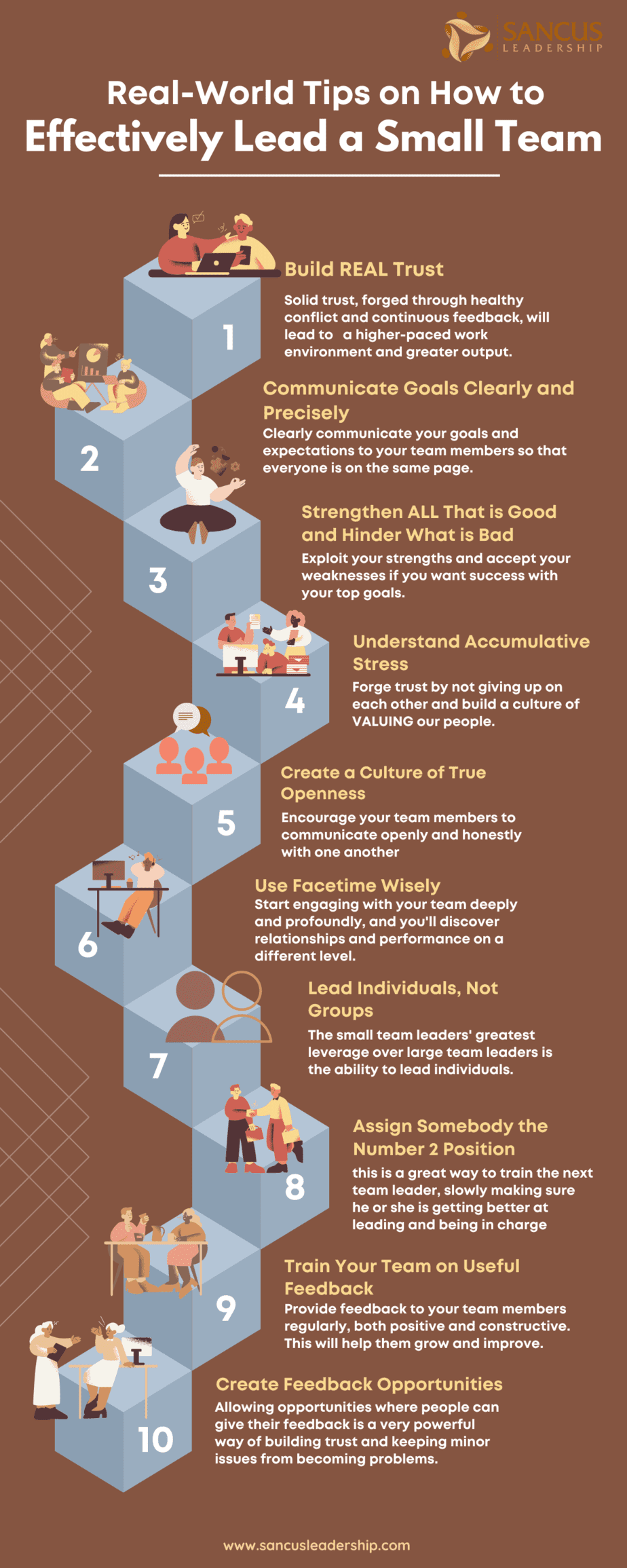
Sources
https://go.frontier.com/business/blog/tips-for-leading-a-small-team-effectively/
https://www.sciencedirect.com/science/article/abs/pii/S0007681304001120
https://www.nytimes.com/guides/business/manage-a-successful-team










